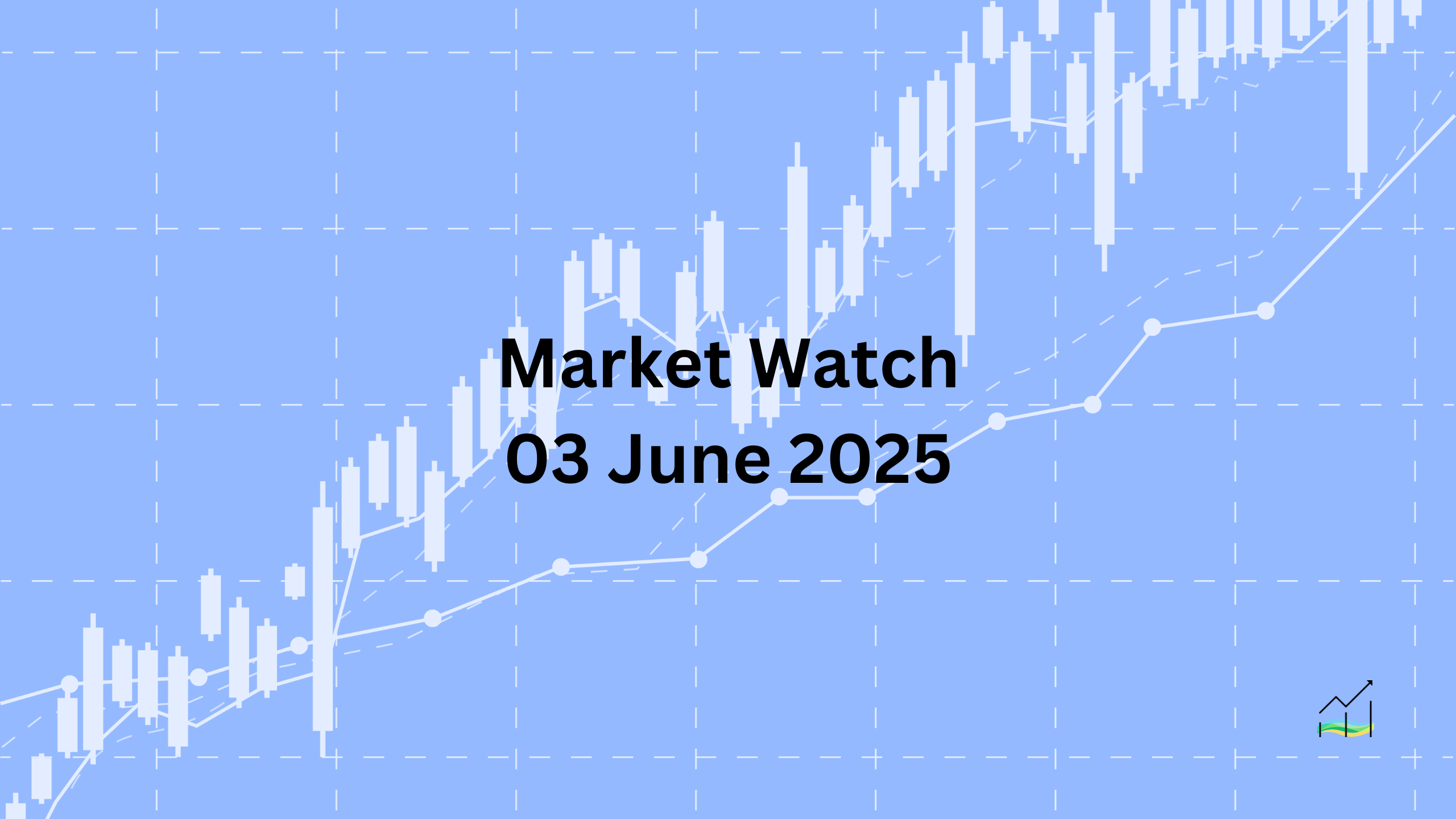03/06/2025 Market Watch

Dollar Strength Holds Steady Amid Mixed Global Market Moves
Key Takeaways:
- US dollar is stronger across G10, but movement remains limited.
- Australian dollar leads losses after dovish central bank minutes.
- Canadian dollar shows resilience; emerging market currencies are mixed.
- European bond yields slightly lower; UK long bond auction supports Gilts.
- Equity markets and gold retreat; oil consolidates gains.
The US dollar remains firm across the G10 space, though its gains have been moderate, suggesting a broader period of consolidation rather than momentum. The Australian dollar was the weakest major currency after dovish signals from its central bank minutes. Meanwhile, the Canadian dollar saw the smallest decline, reflecting a relatively stable domestic backdrop. Early North American trading may bring further modest gains for the greenback.
Emerging market currencies were mixed, with Central European currencies underperforming and the Chinese yuan leading on the upside. The euro softened modestly, reflecting caution in the face of political developments in the Netherlands and broad-based European yield declines. Despite the Dutch government's collapse, bond markets were largely unfazed.
UK bonds drew strong demand in a long-term auction, helping push 10-year Gilt yields lower by about six basis points. US 10-year Treasury yields also edged down, trading near 4.41%, while Japanese long-term yields continued to show divergence across tenors. Equity markets were mixed across regions—most Asian indices advanced, excluding Tokyo, while European and US futures were slightly lower.
Gold prices pulled back after testing a four-week high, while oil markets saw a brief pause in momentum. WTI crude remains near the top of its recent range, suggesting underlying support after Monday’s strong rally.
United States of America
Overview
The Dollar Index briefly dipped below the previous session’s lows but quickly recovered, reflecting a cautious but resilient dollar tone. Market focus has shifted to escalating geopolitical and trade tensions, including a renewed breakdown in US-China trade cooperation, the doubling of US steel and aluminum tariffs starting tomorrow, and growing speculation of potential Russian retaliation following a Ukrainian drone strike.
The OECD revised its US growth forecast downward to 1.6% from 2.8% in March, citing tariff-related inflation pressures. Meanwhile, today’s factory orders offered little new information beyond what was already known from the weak durable goods report, with particular weakness in core capital goods. Boeing’s slump continues to weigh heavily on the data. The JOLTS report, once closely watched, has lost relevance but still points to weakening labour demand if April openings fall to 7.1 million, potentially the lowest since 2020. Auto sales for May are being released throughout the day, with expectations for the first back-to-back monthly decline since late 2023. Surging sales in March were likely front-loaded due to tariff concerns. This lines up with the Q1 GDP revision where consumption was downgraded, reflecting a broader slowdown in consumer durable demand.
Economic Drivers
- Rising trade tensions with China, including the doubling of steel and aluminum tariffs.
- Possible escalation from Russia in response to Ukrainian drone activity.
- OECD downgraded US GDP growth forecast from 2.8% to 1.6%.
- Factory orders reflect broader manufacturing weakness, especially in core capital goods.
- Weaker consumer demand following revised Q1 GDP consumption figures and poor retail sales in April.
Data and Events
- 03 June 2025: Fed Chair Powell Speaks.
- 03 June 2025: JOLTS Job Openings.
Price Action
- Dollar Index dipped below 98.60 before recovering to test 99.00.
- April low at 97.90 remains a longer-term reference point.
Key Points:
- Dollar firmed after testing intraday lows.
- Tariff escalation and geopolitics dominate sentiment.
- Economic data underscores cooling demand and weaker growth.
- Attention remains on upcoming labour and auto sales reports.
- Market volatility tied to trade and inflation concerns.
Australia
Overview
The Australian dollar briefly strengthened at the start of the week, approaching the $0.6500 level after rebounding from support near $0.6400 seen late last week. However, it was unable to sustain those gains as dovish signals from the latest central bank minutes weighed on sentiment. The minutes confirmed a bias toward further easing, with the most recent meeting producing a 25 basis point cut and discussion of a deeper 50 basis point move.
On the data front, Q1 inventories rose more than expected, while net exports subtracted slightly from GDP, providing mixed signals ahead of Thursday's official Q1 GDP release. Economists are now forecasting quarterly growth of around 0.4%, down from 0.6% in Q4 2024. Market expectations for another rate cut in July have increased sharply, with futures pricing in an 80% chance, up from 50% last week. The Australian economy appears to be slowing, reinforcing the central bank’s dovish lean.
Economic Drivers
- Dovish tone in central bank minutes confirmed the potential for further easing.
- A 25 basis point rate cut was delivered, with a 50 basis point move discussed.
- Q1 inventories exceeded expectations, rising by 0.8%.
- Net exports reduced GDP by 0.1 percentage points.
- Market sentiment shifting toward another rate cut next month due to weaker growth.
Data and Events
- 03 June 2025: Monetary Policy Meeting Minutes.
Price Action
- AUD/USD failed to close above the $0.6500 level despite repeated attempts.
- Support near $0.6400 remains intact.
- Aussie slipped back toward $0.6450 following dovish policy signals.
Key Points:
- Australian dollar lost ground after central bank minutes confirmed a dovish outlook.
- Q1 GDP likely to show a slowdown in growth.
- Rate cut expectations for July have increased.
- Market remains sensitive to domestic economic data and policy tone.
Canada
Overview
The Canadian dollar weakened slightly after the US dollar bounced off a marginal new yearly low near CAD1.3675. It has since held above CAD1.3700, as the market reassesses expectations ahead of the Bank of Canada’s policy decision. While recent data confirms a softening Canadian economy, an unexpected uptick in underlying inflation has complicated the rate outlook.
The central bank now faces a more challenging policy setting. Market pricing has shifted notably—where a rate cut was once widely expected, the odds have now decreased sharply. The swaps market currently reflects only a 20% chance of a cut at tomorrow’s meeting, down from roughly 67% before the inflation data. Although the broader outlook still points to easing, the pace and timing remain uncertain, with just under 43 basis points of cuts priced in by year-end.
Economic Drivers
- Canadian economic growth remains soft.
- Recent inflation data showed an unexpected rise in underlying price pressures.
- Central bank decision is complicated by the inflation-growth trade-off.
- Market expectations for a rate cut tomorrow have dropped significantly.
- Broader easing still anticipated by year-end, but at a slower pace.
Data and Events
No major economic releases are scheduled today.
Price Action
- USD/CAD bounced from a marginal new yearly low near CAD1.3675.
- Pair is holding above CAD1.3700, with resistance near CAD1.3750.
- Previous weekly low at CAD1.3685 provides a key short-term reference point.
Key Points:
- Canadian dollar softened as US dollar rebounded from new lows.
- Inflation surprise reduced expectations for a BoC rate cut tomorrow.
- Market still expects easing, but with more caution.
- Policy decision now hinges on managing inflation risk amid weak growth.
China
Overview
Despite broad weakness in the US dollar yesterday, the offshore yuan was one of the few currencies to lose ground. The dollar briefly climbed to a nine-session high near CNH7.2240 before pulling back to the CNH7.1855 area in today’s session. This shift occurred even as the dollar remained firm overall, pointing to renewed demand for the yuan. Last Friday’s low near CNH7.1815 remains a short-term reference.
The People's Bank of China set the daily reference rate slightly higher at CNY7.1869, compared to CNY7.1848 the previous day. The latest data from Caixin’s manufacturing PMI came in below expectations, falling to 48.3 in May from 50.4 in April. This decline contrasts with the official manufacturing PMI, which rose slightly but still remained below the 50-mark, suggesting contraction. The Caixin reading was expected to edge higher, making the drop more concerning. It also marked the first sub-50 reading for Caixin since September last year, signalling fresh signs of weakness in private sector manufacturing.
Economic Drivers
- Offshore yuan underperformed despite broader dollar weakness.
- The PBOC slightly increased the daily reference rate for the yuan.
- Caixin manufacturing PMI dropped unexpectedly to 48.3 in May.
- Official manufacturing PMI improved but remained below 50, pointing to continued contraction.
- Weak manufacturing sentiment raises concerns about private sector activity.
Data and Events
- 03 June 2025: Caixin Manufacturing PMI.
Price Action
- USD/CNH rose to a nine-session high near CNH7.2240 before retreating.
- Pair moved back to CNH7.1855 despite broader dollar strength.
- Friday’s low at CNH7.1815 remains key support.
Key Points:
- Yuan lagged most currencies as US dollar gained.
- PBOC fixed the yuan slightly weaker.
- Caixin PMI fell sharply, highlighting renewed manufacturing weakness.
- Official data showed modest improvement but stayed in contraction territory.
- Market remains sensitive to shifts in sentiment and economic indicators.
Europe & Switzerland
Overview
The euro extended its recent gains, reaching a six-week high near $1.1455 during late North American trading before pulling back toward $1.1400. Despite political instability in the Netherlands following the collapse of the government, markets were largely unaffected. Attention remains focused on the upcoming European Central Bank meeting, especially after a softer-than-expected preliminary May inflation print. The headline CPI came in flat for the month, pushing the year-on-year figure down to 1.9%. Core inflation also eased to 2.3% from 2.7%. These figures support the case for a rate cut this week, though further easing may be delayed due to upcoming base effects that could push inflation higher in the second half of the year.
Meanwhile, Switzerland reported its May inflation data, showing a rare decline in prices. The national CPI dropped 0.1% year-on-year, while the EU harmonized rate fell to -0.2%. This marks the first time since March 2021 that inflation has dipped into negative territory. With inflation turning negative, the Swiss National Bank may be forced to cut rates further. Markets are pricing in 33 basis points of easing at the upcoming policy meeting, with a quarter-point cut being the most probable outcome.
Economic Drivers
- Eurozone May CPI was flat month-on-month; annual rate slowed to 1.9%.
- Core inflation eased to 2.3%, both figures below expectations.
- Inflation base effects in Q3 may lead to upside pressures later in the year.
- Political instability in the Netherlands had limited market impact.
- Swiss inflation turned negative for the first time in over three years.
- Market anticipates a policy response from the SNB due to deflation risks.
Data and Events
- 03 June 2025: CPI Flash Estimate.
Price Action
- EUR/USD reached a six-week high near $1.1455 before retreating to $1.1400.
- A break below $1.1385 would signal weakening momentum.
- Euro remains firm ahead of key ECB policy decision.
Key Points:
- Euro tested multi-week highs but faced resistance near $1.1455.
- Softer inflation supports an ECB rate cut, but future cuts may be limited.
- Swiss CPI fell below zero, pressuring SNB to cut rates this month.
- Markets are watching central bank signals closely for next direction.
Japan
Overview
Rising trade tensions between the US and Japan have taken center stage following the US decision to double steel and aluminum tariffs. This move has added strain to bilateral negotiations, with Prime Minister Ishiba firmly stating that Japan will not make concessions on the matter. The firm stance from Tokyo signals limited flexibility in future talks, making any breakthrough in trade discussions increasingly unlikely in the short term.
These developments come as market sentiment shifts, with the Japanese yen gaining ground against the US dollar. The dollar briefly fell to a five-day low near JPY142.40 before recovering slightly. Political resistance to US tariff pressure, coupled with increasing uncertainty in US-Japan trade relations, has added to the yen’s appeal during risk-sensitive sessions.
Economic Drivers
- The US has announced a doubling of tariffs on Japanese steel and aluminum.
- Prime Minister Ishiba rejected the possibility of Japan making concessions on tariffs.
- Rising tensions risk complicating broader US-Japan trade negotiations.
- Market sentiment is sensitive to political developments impacting bilateral relations.
Data and Events
- 03 June 2025: 10-y Bond Auction.
- 03 June 2025: BOJ Gov Ueda Speaks.
Price Action
- USD/JPY fell to a five-day low near JPY142.40.
- Broke below a key trendline drawn from April and May lows near JPY142.50.
- Recovered to JPY143.25 before consolidating.
- Momentum points to a possible retest of session highs in North American trading.
Key Points:
- US tariff hike worsens trade tensions with Japan.
- Japanese leadership remains firm on rejecting tariff-related concessions.
- Dollar-yen pair tested five-day lows before recovering.
- Yen strength reflects heightened trade-related uncertainty.
© 2025 SKONE Enterprise (003319453-V). All rights reserved.
The content on this site is for informational purposes only and does not constitute financial advice.


